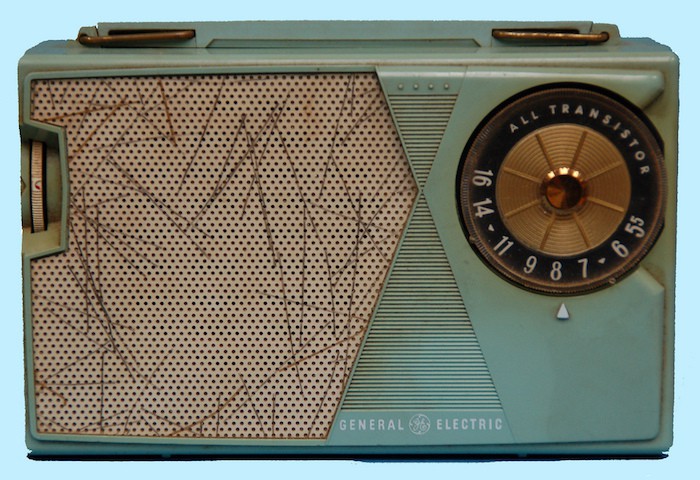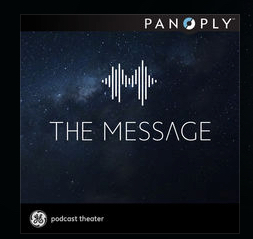
It’s no secret that the fictional sci-fi podcast The Message is co-produced by GE. But to the million-plus listeners who, as of last week, had pushed the eight-episode series into the No. 1 podcast slot on iTunes, that doesn’t seem to matter.
“You should start a Kickstarter for a film,” one reviewer said on the podcast’s iTunes page, giving it 5 stars. “Such a good story, would be great on screen.”
 Inherent in the Kickstarter comment is the assumption that podcasts are still a scrappy business, struggling to stay afloat. In the podcast world, GE’s collaboration with Slate’s podcast network Panoply Media is a new and still somewhat controversial idea. If sponsored content is now considered old news in the world of text-based online media, it’s still a fairly new prospect when it comes to big brands funding podcasts. But it’s likely that this model will come to coexist alongside other podcast business models, like host-read advertisements, programmatic advertising, and reader donations or paywalls.
Inherent in the Kickstarter comment is the assumption that podcasts are still a scrappy business, struggling to stay afloat. In the podcast world, GE’s collaboration with Slate’s podcast network Panoply Media is a new and still somewhat controversial idea. If sponsored content is now considered old news in the world of text-based online media, it’s still a fairly new prospect when it comes to big brands funding podcasts. But it’s likely that this model will come to coexist alongside other podcast business models, like host-read advertisements, programmatic advertising, and reader donations or paywalls.
“In podcasting, we’re kind of where the film industry was in the 1910s,” Andy Bowers, chief content officer of Panoply, told me. “We are trying lots of different models for how to make things work. There’s regular ad-supported, there are things like this custom project, there are things that are behind paywalls, and we’re all still discovering what forms the audience likes the most…I think this is one among many models that will prove durable in the podcasting space.”
Branded content isn’t new to Panoply, which the Slate Media Group launched this past February after sustained early investment in the podcast space. The network has a custom arm to work with brands and has already done projects like a series of companion podcasts for HBO Documentary Films.Panoply follows the same rules for sponsored content that Slate follows on the print side: “The content is clearly labeled as coming from a sponsor, and readers are never confused,” Bowers explained. “We follow the same rules for the custom podcasts in our network.”
The Message, however, is by far the most complex branded project that Panoply has worked on. While GE and Panoply wouldn’t share specifics about how it was funded, Bowers said that Panoply “ran and paid for the production.” That included hiring the writer (playwright Mac Rogers) and hiring the actors, producers, and sound designers.
GE came up with the original concept for The Message, provided feedback during the writing process, and created spinoff websites to create a fuller universe around the show.
“It’s like GE creating a TV show,” said Andy Goldberg, chief creative officer at GE. “I don’t consider it advertising. It’s a podcast show that just happens to be produced by a brand instead of a network. I’m not saying, ‘Hey, go out and buy a jet engine.’ It’s a science fiction story to connect listeners with what the GE brand is about, without selling the GE brand.”
Sunday is the final episode of The Message.
Catch up on the sci-fi pod by @Panoply & @GE: https://t.co/zvK79fbXjN pic.twitter.com/nE1P1JgZIH
— Slate (@Slate) November 20, 2015
In the creation of the podcast, “GE had a light touch,” said Bowers. “They wanted it to touch on themes that were important to the work they do. We found a few places where there were some overlaps with the technology that they do, so it was baked in there. But the writing and the creative part came first.”
Rogers, the series’ writer, described the process in an article for Slate. He only mentions GE once, here:
With The Message, I quickly realized that the alien menace had to be a sound. Badly written radio drama is absolutely rife with people shrieking ‘Dear God, it’s 10 feet tall and ringed with tentacles!’ because listeners can’t see the ring of tentacles. But I recalled the marvelous Doctor Who audio play Scherzo, in which the doctor and his companion are stalked on a zero-visibility planet by a creature made of sound. This stroke of genius by author Robert Shearman ensured that the doctor and the listeners would have the exact same experiences of the monster. In an early meeting for The Message, I learned that our sponsor, GE, was one of several companies doing pioneering work in sound-based medical treatments. My mind immediately jumped to: If a sound can cure a person, maybe it can also make them sick? And just like that I knew I had my monster.
It’s entirely possible to listen to The Message without ever realizing GE’s role in it. That may be, in part, because it’s fictional. “The success of fictional podcasts ultimately comes down to the quality of the writing,” Goldberg said. “If the story’s not there, it doesn’t really matter. What I love more than anything is that it’s an opportunity for people to use a different sense: Forcing people to paint the picture with their mind, off of something on audio, is pretty exciting and different” for both brands and products.
When it comes to nonfictional podcasts, however, the debate over branded content can be sharper. Gimlet Media talked in the most recent episode of its podcast StartUp about launching its own branded content division, and the entire episode was devoted to the thinking behind that decision — as well as the inevitable debates between Gimlet and the brands that want it to create podcasts for them.Panoply “has always been a network comprising content from lots of different companies, primarily big media outlets,” Bowers said. “Nearly everything in the network is already co-branded, so doing the same with custom content makes sense for us.”
Gimlet, by contrast, has always produced its own shows in-house, so its concerns about branded content are different. On that episode of StartUp, Nazanin Rafsanjani, Gimlet’s recently hired creative director, explains how she sees the company’s branded content model working:
Really, the only model that we would consider was, essentially, that it would have nothing to do with our brand. Our listeners would never be confused…We create a podcast series for you [the brand], we give it to you, and you build your audience from zero around that podcast series. It’s up to you. We just make it for you and we hand it over to you. We don’t use any of our existing podcast channels to distribute it to anybody.
The real-estate website Zillow is one of the companies that wants Gimlet to produce a podcast for it. Gimlet gives Zillow a proposal to produce six 20- to 30-minute episodes, with a cost “well into the six digits.”
When, on the podcast, Rafsanjari and Zillow PR person Emily Heffter discuss the proposal, it’s clear how far apart the two companies are.
“We liked the ideas and everything in the proposal, but we felt like it misunderstood a little what it is we’re trying to do,” Heffter says. “The cost is one problem; it’s just way, way more than we were thinking.” She won’t say the figure that Zillow had had in mind, but “like, what do we get for $50, what do we get for $450,000?”
And Zillow wants “to pursue more of something that’s an editorial partnership,” Heffter explains. “Meaning less of, like, a heavily branded Zillow podcast, and more something that is a Gimlet podcast!”
“We can’t partner with a brand and give them editorial say in the content if it’s a Gimlet podcast,” Rafsanjani responds, though she concludes that “there’s a lot of potential here.”
Later, after the call, she says: “They want us to make a podcast for them that we put out over our channels but then they edit it with us…of course that’s what they want, because that would be great for them.” She worries that “companies aren’t gonna want to do the extremely narrow thing that we want to do, which is make you a super-expensive, white-label podcast that we do not distribute and we do not pass off as our own in any way, shape, or form.”As of last week, Gimlet hadn’t announced any branded content clients, though it has posted its new guidelines to its site. But its struggles foreshadow the issues that are bound to arise as podcast networks grapple with sponsored content.
In the meantime, maybe others should consider getting into fictional podcasts.
“The Message is a special case because, in addition to being labeled as GE Podcast Theater, it’s also a fictional story, meaning there’s no chance of confusion over whether it’s a piece of editorially independent journalism,” Slate’s Bowers told me. “It’s entertainment. And we’re proud to have our name on it alongside GE’s.”